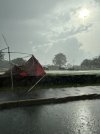Unless I’m misunderstanding what I’m seeing in these pictures, I disagree. Looks like low end EF2 max to me. EF3 seems like it would be more significant damage to structures than that.Looks like high end EF2, one could argue low end EF3 damage.
Navigation
Install the app
How to install the app on iOS
Follow along with the video below to see how to install our site as a web app on your home screen.
Note: This feature may not be available in some browsers.
More options
-
Welcome to TalkWeather! We see you lurking around TalkWeather! Take the extra step and join us today to view attachments, see less ads and maybe even join the discussion. CLICK TO JOIN TALKWEATHER
You are using an out of date browser. It may not display this or other websites correctly.
You should upgrade or use an alternative browser.
You should upgrade or use an alternative browser.
Severe Threat May 15-16, 2025
- Thread starter CheeselandSkies
- Start date
Kds86z
Member
Yeah still early ..we know 2025 likes evenings.Hard to disagree. Star of the show has definitely been the St. Louis tornado. Still a long way to go, but thankful that the ceiling that this synoptic setup consisted of has definitely not reached it as of yet (probably won't).
US_Highway15
Member
US_Highway15
Member
Looking at it again, definitely correct. Think it's EF2 damage, because of the roofs being torn off the brick buildings, unless those were already torn off. If they were already torn off before the tornado, then EF1.Unless I’m misunderstanding what I’m seeing in these pictures, I disagree. Looks like low end EF2 max to me. EF3 seems like it would be more significant damage to structures than that.
Reminder that the LLJ has not strengthened yet. Profiles now favor large hail, and tornadoes where storm scale factors (such as merger induced RFD surges, or nudgers) allow. That is exactly what has happened. The main LLJ segment is currently just behind the main storms, will begin strengthening now, and move East over the next few hours. In fact, the VAD from Paducah has increased the 0-1km SRH from 180m2/s2 to 260m2/s2 in the last 15-20 minutes. So long story short, do not dismiss the rest of the evening based on the expected hail dominant mode now.
Since bridges across the Mississippi River are fairly sparse in that area, any available bridges will naturally end up forming a chokepoint. That's what we're seeing right now.
zath
Member
But.... the VAD from Paducah is contaminated because the supercell is right over it, so I wouldn't trust it too much.Reminder that the LLJ has not strengthened yet. Profiles now favor large hail, and tornadoes where storm scale factors (such as merger induced RFD surges, or nudgers) allow. That is exactly what has happened. The main LLJ segment is currently just behind the main storms, will begin strengthening now, and move East over the next few hours. In fact, the VAD from Paducah has increased the 0-1km SRH from 180m2/s2 to 260m2/s2 in the last 15-20 minutes. So long story short, do not dismiss the rest of the evening based on the expected hail dominant mode now.
Looking at the models, the LLJ still shows winds coming out of the SW over the next several hours which is not the most conducive for tornadoes today.
TornadoFan
Member
Don't know that for sure.But.... the VAD from Paducah is contaminated because the supercell is right over it, so I wouldn't trust it too much.
Looking at the models, the LLJ still shows winds coming out of the SW over the next several hours which is not the most conducive for tornadoes today.
US_Highway15
Member
It's possible, though I still think it's reflecting the increase in LLJ - similar increases occurring on KVWX radar to the north.But.... the VAD from Paducah is contaminated because the supercell is right over it, so I wouldn't trust it too much.
Looking at the models, the LLJ still shows winds coming out of the SW over the next several hours which is not the most conducive for tornadoes today.
OhOkayThen
Member
I'm gonna say it, I'm surprised (but can in a way understand) that NWS Paducah has kept the Tornado Warning in place since the storm has turned more outflow for the time being.View attachment 41887
Ever since they lost the top guy there a couple months ago, it's been a way different office. Went from very conservative to very progressive in terms of wording and warning issuance.
WhirlingWx
Member
I believe this should say I-55
warneagle
Member
zath
Member
For sure! My concern though is it seems like mostly a speed shear that is increasing, rather than directional shear. The hodographs still seem fairly linear as opposed to wide sickle-shaped. That is what mostly drives my thought that long-lived/strong tornadoes - while still possible - is lower compared to shorter-lived tornadoes.It's possible, though I still think it's reflecting the increase in LLJ - similar increases occurring on KVWX radar to the north.
TornadoFan
Member
The storm east of Farmington, MO might be getting ready to produce.
TornadoFan
Member
Speak of the devil. Just went tornado warned.The storm east of Farmington, MO might be getting ready to produce.







